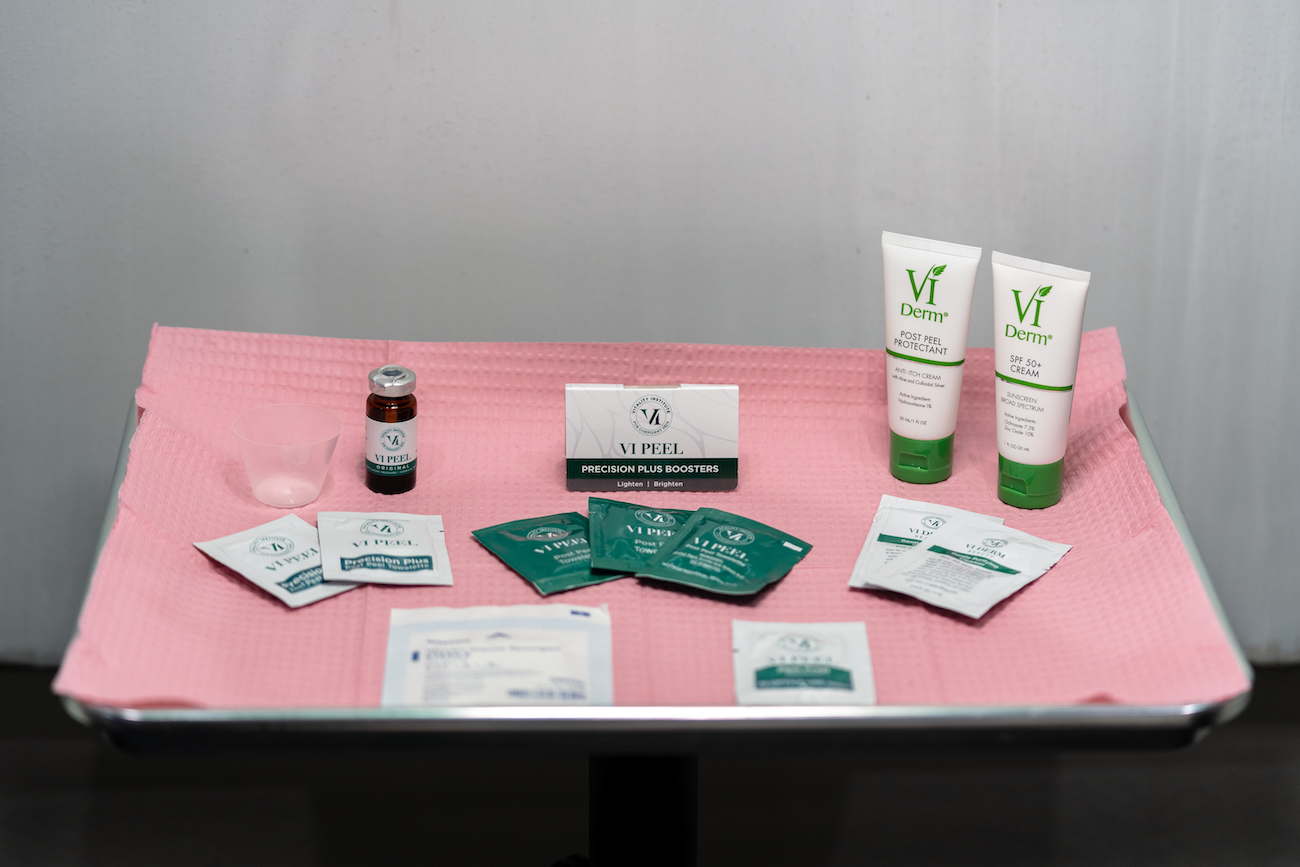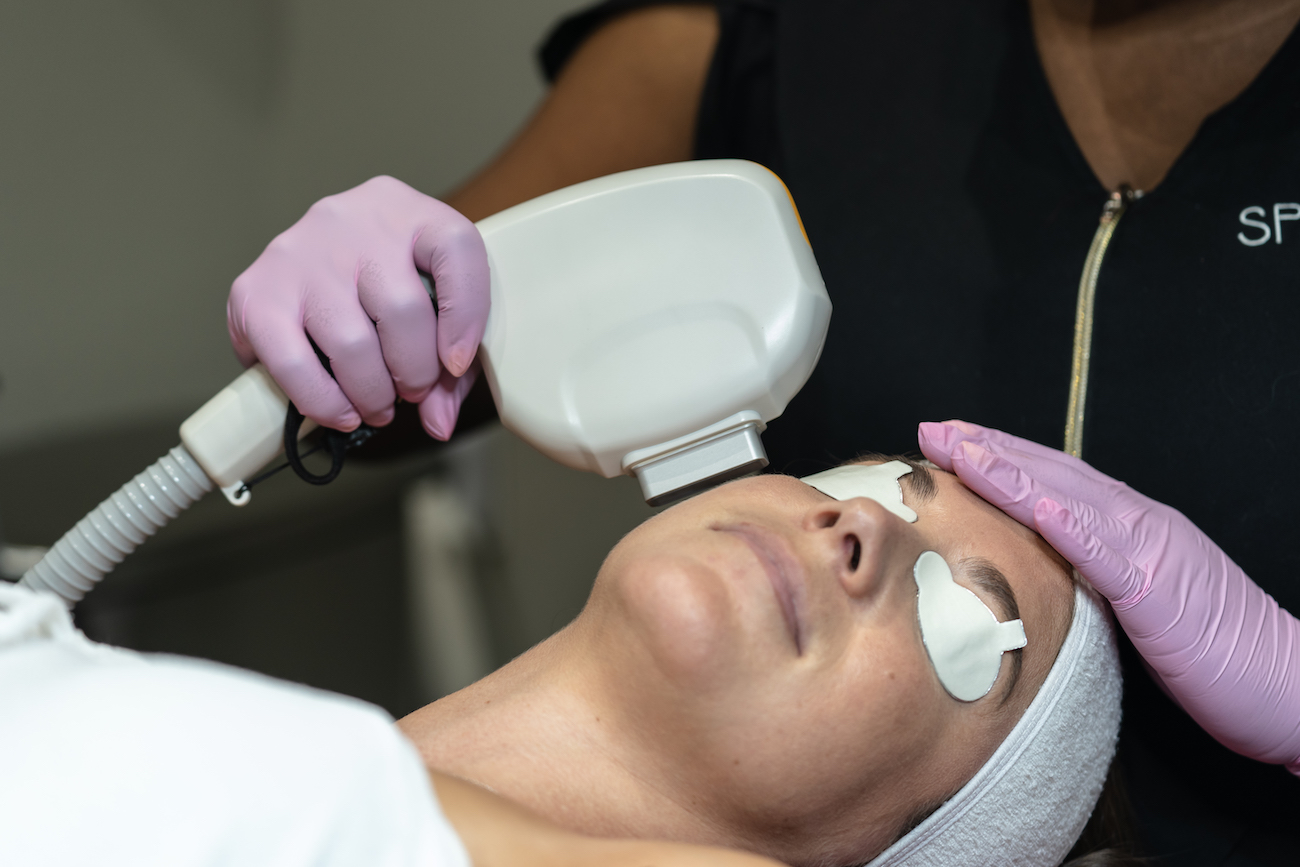Discover Our Hyperpigmentation Treatments in Dallas at Spa in the City
Hyperpigmentation is a form of skin discoloration that can stem from many environmental and genetic factors. What’s less than ideal is how it can make your complexion appear uneven and textured. While certain types of discoloration may not be harmful, it can definitely make you feel self-conscious. Sometimes hyperpigmentation is preventable (such as sun damage), but other times it’s unavoidable, like melasma from hormonal changes.
One thing we know at Spa in the City is that hyperpigmentation is a top skin concern for our clients at our Dallas medical spa. The good news is we have multiple hyperpigmentation treatments for different forms of hyperpigmentation!
Below we discuss different types of hyperpigmentation, how sunscreen can prevent sun damage discoloration, and our hyperpigmentation treatments in Dallas at Spa in the City.
What is hyperpigmentation?
If you break it down, hyper means an excess of something, and pigmentation refers to the amount of color in the skin. Hyperpigmentation shows up as areas of your skin that are darker than your natural skin tone, making your complexion uneven.
There are multiple types of hyperpigmentation, mainly:
- Melasma
- Sun damage / sun spots
- Post-inflammatory hyperpigmentation
To better understand these skin conditions, let’s discuss what causes them 👇
Causes of melasma
Melasma is especially common in women–love that for us! Seriously, around 90% of those with melasma are women.
This number makes sense because we believe hormonal changes to be the primary cause of melasma, especially during pregnancy. 15 to 50% of pregnant women experience it; because of its appearance primarily around the nose and cheek area, melasma is colloquially known as “pregnancy mask.” Other common causes are certain types of medications, birth control, genetics, and sun exposure.
What it looks like
Melasma color ranges from light to dark brown and can appear on your face, shoulders, neck, forearms–basically anywhere exposed to the most sunlight. It appears in small or larger unraised patches.
Causes of sun damage
It’s pretty obvious that sun exposure causes sun damage, but to get into specifics, it’s ultraviolet (UV) light that damages your skin. Though other forms of UV light, like tanning beds, can cause photodamage, the sun is the major proponent of this type of skin damage.
According to Yale Medicine, sun damage happens in deeper layers of the skin and can take years to surface. This means what looks like a mild sunburn at first can show up as sun spots much later.
Of course, there is also the risk of skin cancer from sun damage. We strongly recommend wearing SPF 30 or higher every day and reapplying as needed! Daily sunscreen use along with hats, protective clothing, staying in the shade, and other good habits can help reduce your risk of developing sun damage.
What it looks like
Hyperpigmentation from sun damage looks like uneven pigmentation and discoloration across the skin in areas like the face, neck, chest, and other areas that receive the most sun exposure. This could be light to dark brown or red tones. Sun damage also increases the formation of fine lines and wrinkles and skin laxity, or loose, sagging skin.
Causes of post-inflammatory hyperpigmentation
Post-inflammatory hyperpigmentation occurs when your skin heals from some type of inflammation. The most common type of post-inflammatory hyperpigmentation is from acne, but it can also occur from skin trauma like a burn. Some people’s skin types are more prone to this type of hyperpigmentation than others where your skin takes weeks or even months to fade away the post-inflammatory hyperpigmentation.
What it looks like
Post-inflammatory hyperpigmentation looks like flat red or brown spots that appear in areas that were once inflamed. For example, if you had a particularly angry pimple that finally said see ya later, you may notice some hyperpigmentation where it once was as your skin heals.
Sun damage versus melasma: what’s the difference?
The causes of sun damage and melasma set the two apart. Prolonged sun exposure without protection causes sun damage, while hormonal changes, especially those in pregnant women, cause melasma.
Melasma appears in larger blotches with light brown to darker brown patches. Sun damage may present with slight discoloration in multiple smaller areas throughout. Our skin professionals at Spa in the City can help you understand the difference and find the best treatments for you!
Preventing sun damage
For the best protection, we recommend wearing a broad spectrum sunscreen every day with SPF 30 or higher. There are so many options for sunscreen out there, we find that it’s hard to say what type of sunscreen is the absolute best.
To find the sunscreen that will work best for your personal needs, let’s talk about the difference between chemical and physical sunscreen, plus the pros and cons for each.
Chemical sunscreen
Chemical sunscreen is the modern, easy to apply sunscreen that easily absorbs into the skin.
Pros
- Convenient, easy to work into the skin
- Less chance of leaving a white cast on darker skin tones
- Easy to find in the store
Cons
- Require some time to sink in fully
- Can be more irritating because of more ingredients
Physical sunscreen
Physical sunscreen, also known as sun block, forms a physical barrier on your skin, so it does not absorb like a chemical sunscreen. These types of sunscreens use zinc oxide and titanium oxide to block both UVA and UVA light.
Pros
- Naturally broad-spectrum, protecting you from multiple forms of light
- Works immediately
- Uses less ingredients
Cons
- Often difficult to work into the skin
- Can leave a white cast on darker skin tones
- May rub off easily
Other ways to prevent sun damage
Besides making SPF your best friend, there are many other ways to help prevent sun damage on your face and body!
- Wear a hat to cover your face and neck
- Make plans based on the day’s UV index
- Wear glasses with UV light protection
- Spend time outside in the shade
- Wear SPF protective clothing
Hyperpigmentation Treatments in Dallas
Chemical Peels
Chemical peels can help soften a rough-textured surface, improve dull skin, and add moisture to dry cells. These peels can counteract sun-damaged skin and pre-cancerous cells it may contain. A chemical peel also creates an even skin tone by lightening freckles, sun damage, age spots, and blotchy skin caused by certain medications.
Treatable conditions:
- Sun damage
- Acne & acne scars
- Fine lines & wrinkles
- Dull skin
- Enlarged pores
- Rough texture
- Age spots
- Melasma
For a deeper peel treatment, check out our VI Peel.

RF Microneedling
RF microneedling is a process where we evenly stamp minuscule needles directly into your skin. By causing minor skin damage, your skin thinks it is under attack and reacts by producing more collagen and elastin. Because of this procedure, you could benefit from plumper, smoother, and more luminous skin.
Treatable conditions:
- Fine lines and wrinkles
- Surgical and acne scars
- Enlarged pores
- Skin pigmentation issues
- Sun spots
- Much more!
RF microneedling is a fantastic alternative to laser treatments, which is a common concern for those with darker skin tones.
Clear + Brilliant
The laser energy used in Clear + Brilliant treatments can renew the texture of dry or rough surface skin, reduce large pores, smooth acne scars, and improve tone.
Treatable conditions:
- Fine lines
- Wrinkles
- Enlarged pores
- Uneven skin tone
- Rough texture
- Melasma
While the laser damages compromised collagen and other proteins that clutter the deepest layers, it also opens the epidermis to allow nutrient-infused serums to work their magic.
Photofacial
Photofacials using intense pulsed light (IPL) are noninvasive therapies that treat skin damage without disruption of the skin’s surface, hence, no downtime.
Treatable conditions:
- Sun damage
- Enlarged pores
- Visible blood vessels
- Acne & acne scars
- Redness & rosacea
IPL can simultaneously manage a broad range of facial concerns safely and effectively. We can address conditions such as benign brown pigmented lesions, broken capillaries, sun-induced freckles known as age spots, mottled pigmentation and poikiloderma with IPL.

Pixel Laser
The Pixel laser is a deeply penetrating laser treatment that visibly improves a variety of skin concerns. In 2006, Pixel by Alma became the first FDA-approved ablative fractional laser skin resurfacing method that was as gentle as a non-ablative laser with just a few days of social downtime for patients.
Treatable conditions:
- Acne scarring and depressions
- Fine to moderate lines and crepey wrinkles
- Hyper-pigmentation and Melasma
- Age spots
- Years of sun damage
- Large, visible pore size
- Roughly textured skin
Most laser systems cap at 1064nm which is less than half the strength of the Pixel; now you can get through to the deepest, most damaged sections of the dermis to begin the necessary restructuring.
Get the best hyperpigmentation treatments in Dallas at Spa in the City!
Whether you’re looking to improve the appearance of melasma, sun damage, or another type of skin discoloration, we have some of the best options for hyperpigmentation treatments in Dallas!
The team at Spa in the City is dedicated to providing the best, most natural-looking results possible. Our goal is for you to feel better in your skin, not erase your natural beauty. We will provide excellent client care while producing exceptional results for your hyperpigmentation concerns. And, as always, we strive to find options that fit into your budget.